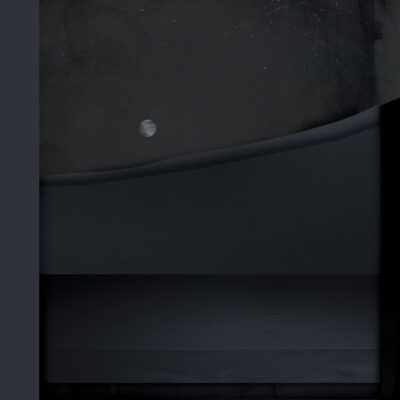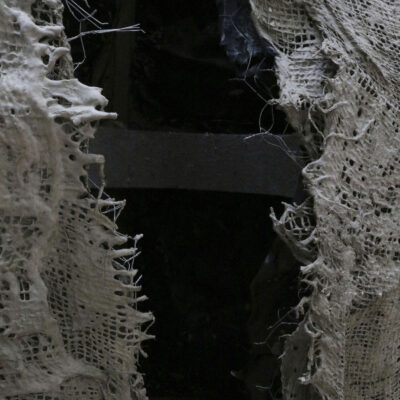
Sound Art Editions






Mercurial enigma Cindytalk advances from decades of work with everyone from Cocteau Twins and This Mortal Coil to Robert Hampson and Ancient Methods with the bleakest invocation of their native Scottish wilderness for Richard Chartier’s Line imprint.
Admired as an artist who not only appeared on Cocteau Twins’ ‘Garlands’, but was also crucial to early hardcore techno as Bambule, and made a gorgeous cover of Ewan Pearson & Peggy Seeger’s ‘The First Time Ever…’, Cindytalk’s talents are hard to measure. ‘When the Moon is a Thread’ only complicates that matter by adding a dose of vicious, unheimlich, yet at times, lush, electronic noise to their personal mix with four pieces recorded 2013-2023 in Kobe, London, and Glasgow that speak to a life well travelled, but is also distinctly rooted in a sort of bittersweet, northerly romance that bleeds out and resounds in their music, no matter the style.
Their distinguished feel for tone resonates in the metallic timbres and widescreen plangency of ‘sleeping and dreaming’, which conversely approximates the sensation of sleep paralysis and suspension between worlds in its escalation to gnawing, wraithlike noise. ‘let love burn’ can be heard to characterise their sense of a tortured romance in its transition from guttural unease to distant pangs of speedcore blast beats, and the 14 minutes of ‘another year goes by’ full commits to hellish atonality before erupting 7 minutes in, into Charlemagne Palestine or Pita-like raptures. ‘in the middle of the night’ is the one for discerning dark ambient souls, moving at the speed of witching hour thought between what sounds like Harry Bertoia sculptures animated in subzero.
—boomkat.com
If you’re not familiar with the work of Cindytalk – a mostly solo endeavor, originated by musician Cinder in 1982, that explores sound, art, and identity through goth, “ambi-dustrial” and experimental music – then a glance at When the Moon is a Thread, their latest album on Richard Chartier’s LINE label, might suggest you’d be in for an austere, even chilly listening experience. The striking cover art is an image of the rim of the Shackleton Crater on the moon’s south pole, the interior of which has never been touched by the rays of the sun. And the song titles all point to inexorable transformation, loss, and the passage of time.
If, however, you are familiar with the work of Cindytalk, then you know to expect the unexpected. The material on When the Moon is a Thread very nearly defies description while it expands the possibilities of noise and music, and the places where they intersect and cross-pollinate.
The slow-build opening of “sleeping and dreaming” is torn apart by a steady, relentless series of sonic thrusts and echoing bursts. Teeming, seething clouds of prickly, piercing, high-pitched static swarm and phase and circulate above. Cinder thickens the mix, pouring in new textures, pulling existing elements back and pushing others forward, while conjuring up a churning, volatile battlefield atmosphere that is at once alien, menacing, and fantastically alive. That it maintains its magnetic presence for over 15 minutes is testament to their deft sense of pacing and deep feel for textured sound.
In the wake of that brooding maelstrom comes “let love burn,” the shortest track and a comparatively subdued one of chthonic throbs and gaping metallic cries that drift unheeded through what feel like millennium-deep caverns of time and space. “Another year goes by” starts out as a skull-scouring storm of granulated glass, susurrated curses, and digitized staccato clatter buttressed by ominous chords. A sparkling, diaphanous tone-cloud sweeps everything aside only to become a hissing squall of static before reverting to its gentler form. Following its unsettled dream logic, the track fades in a hail of sputter and ruffle and boil.
Not going out gently, the album closes with “in the middle of the night,” a somnambulistic, drifting journey across a terrain watched over by clacking machinery. Humid gusts of smoky air hover among crystalline atonal pads and foghorn bass notes. Alarm bells ring out randomly, signifying nothing. From this scattering and disuse, a crippled melody emerges in a string of dense, plaintive chords—the album’s only instance of melody —saturating the scene with the colors of sorrow while holding it in place and slowly draining it of momentum. The track cuts off abruptly in a juddering, concussive collapse.
Bewitching, harrowing, and melancholic, often within the span of a single track, When the Moon is a Thread is the most satisfying Cindytalk album in years.
—acloserlisten.com
